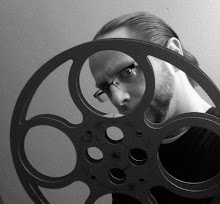In 1959, author Robert Bloch penned a suspense novel by the
name of PSYCHO, which was based on the bloody murders committed by Ed Gein in
Wisconsin just two years before. In 1960, despite objections from the studios,
famed director Alfred Hitchcock decided to adapt PSYCHO into a feature film.
Here in 2012, we have director Sacha Gervasi’s HITCHCOCK, which aims to tell
the story of how all it all came about.
Alfred Hitchcock (Anthony Hopkins), is fresh off the success
of his latest film, but is feeling very much his 60 years and wants to do
something fresh and new. With the help of his wife and film-collaborator Alma
(Helen Mirren), he works to adapt the novel PSYCHO to the big screen, despite
the financial and personal risks, and the objections from studios.
HITCHCOCK marvelously re-creates the settings from PSYCHO so
well, fans of the famous film will instantly be thrilled, and non-fans will be
inspired to finally see it. It is a treat to see such famous scenes re-created
and what went on behind-the-scenes (and the shower curtain) to make them
happen. However, HITCHCOCK smartly keeps those peeks behind the walls scattered
and few, as this is a story of not just how PSYCHO got made, but why. It is
very much Hitchcock’s story, as great and good lengths are taken to show and
tell what was driving him to make what was considered to be such a risk back
then. HITCHCOCK evolves into a family drama; as the strained relationship with
his wife goes, so goes the production of the film.
Director Sacha Gervasi (in his first fictional film) manages
to take things a level deeper; there are several peeks into the mind of
Hitchcock himself. Hitchcock re-imagines the murders committed by Gein in his
mind; extensive peeks in which he himself has conversations with the mass
murderer. The imagined scenes never feel out-of-place, as they eventually help
Hitchcock find his inspiration, which in turn moves the overall plot forward as
he makes his film.
As smart as things are, HITCHCOCK never seems to break away
from anything seen before as far as dramatic arcs go. Gervasi seems to be
following the standard blueprint (rise, fall, rise again), and as enjoyable as
the film is, feels small and simple by the time it wraps.
But keeping the simplicity afloat are the incredible
performances by the cast. When casting actors to portray historical figures,
finding look-alikes is half the battle, and HITCHCOCK knocks it out of the park
with Hopkins (who vanishes inside Alfred Hitchcock), and Scarlett Johansson
(who is a dead-ringer for Janet Leigh). Film fans who are familiar with the
work of these two Hollywood heavyweights will think that the two had grown
young again. Helen Mirren is memorizing, and the rest of the cast, which
includes Toni Collette, Danny Huston, Jessica Biel, Ralph Macchio (!), and
James D’Arcy (who creepily looks a lot like Anthony Perkins). In keeping with Hitchcock tradition, the film is “hosted” by Hitchcock himself. It’s a clever and humorous move which will have film-buffs smiling from ear-to-ear. HITCHCOCK will thrill hard-core movie fans, and it will also generate interest for newcomers in one of the most important people in movie history.
BOTTOM LINE: See it


















